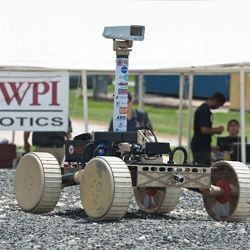
The success of the nation’s first undergrad robotics engineering program has inspired at least two universities that are now experiencing the very same challenges.
The highest hurdle, they agree, is to make the program function not just within computer science nor electrical and computer engineering nor mechanical engineering, but with faculty from all three departments working together to support a multiple-disciplinary program.
Six years ago, Worcester, MA-based Worcester Polytechnic Institute’s (WPI’s) new robotics initiative had no students, one class, and one faculty member. Today it’s accredited by ABET, offers a BS degree as well as an MS and Ph.D., and has 50 graduate students, 240 undergrads, 11 faculty, 17 courses, and 11 labs.
"Previously a quarter of our students came from outside New England," says Michael Gennert who, in 2007, headed up WPI’s CS department but is today the school’s robotics engineering program director. "Now we’ve become known as the robotics school and, because of our heightened visibility, half of our robotics students come from more diverse geographies."
To date, WPI has received several million dollars in robotics research funding from the NSF, NIH, NASA, DARPA, and industry. And it’s had 98 graduates, 94% of which have gone on to graduate school or industry. Others are now working at robotics companies like iRobot and Kiva, and non-robotics companies like BAE and Raytheon.
"We’ve even had a company spinoff–Neuron Robotics–which builds robotic hardware," says Gennert.
WPI’s success quickly became evident to two other schools–Southfield, MI-based Lawrence Technological University–which contacted Gennert to determine what it would require to jump on the robotics bandwagon–and the University of California, Santa Cruz.
"We’d gotten word the Army would be moving TARDEC–its biggest robotics research center–to Michigan which was going to create about 2,500 jobs in robotics," says Giscard Kfoury, who had been assistant professor of mechanical engineering at Lawrence Tech and is now director of its robotics engineering program. "Plus the fact that there are over 250 robotics companies in Michigan, and so there was considerable interest in our having an undergrad robotics program."
After determining that WPI was the only U.S. university Kfoury was aware of that gave a bachelors degree in robotics, he visited the school in the fall last year, met with Gennert and the robotics faculty, looked at their program, and used it as a benchmark for what Lawrence Tech wanted to accomplish.
"It was clear to us, just as it was to WPI, that three disciplines–computer science, electrical and computer engineering, and mechanical engineering–need to be equally involved, which becomes quite a challenge because each has different ideas of how to approach the program," Kfoury says. "So it’s a delicate balance that takes everybody out of their comfort zone. But sometimes, in order to innovate, you need to do things differently than the usual way you do them."
The first semester for Lawrence Tech’s program–which offers a BS in robotics engineering–began in late August of 2011 with three students and Kfoury expects that will grow to 20 when the program begins its second year this month.
"If I had to speculate, this program could grow at the rate of 100% a year," he says. "I’m getting calls from parents whose kids are four years away from college and they’re asking me what classes they need to take to be able to enroll in our program when they enter college. Robotics creates that kind of excitement. Which makes advertising the program almost effortless; as soon as people hear about it, they’re interested in learning more."
Paul Hyman is a science and technology writer based in Great Neck, NY.



Join the Discussion (0)
Become a Member or Sign In to Post a Comment